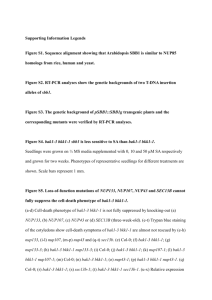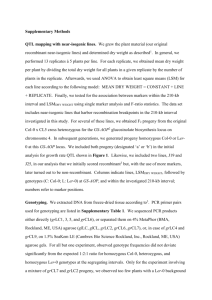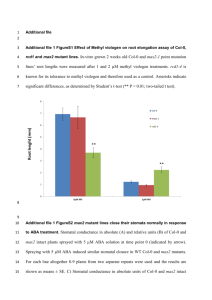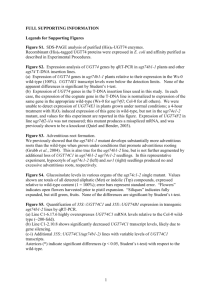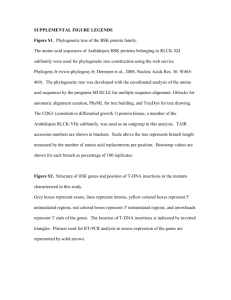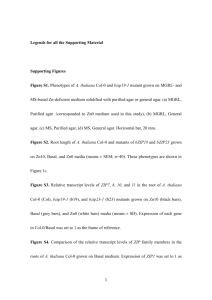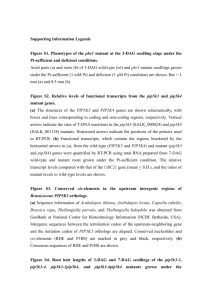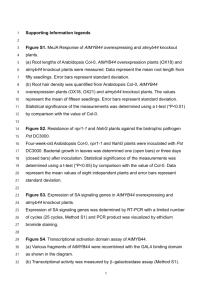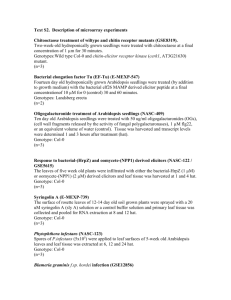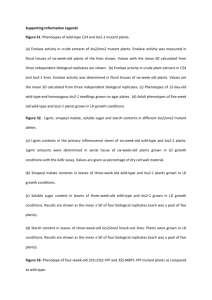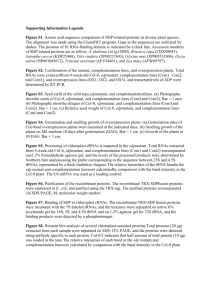tpj12902-sup-0006
advertisement
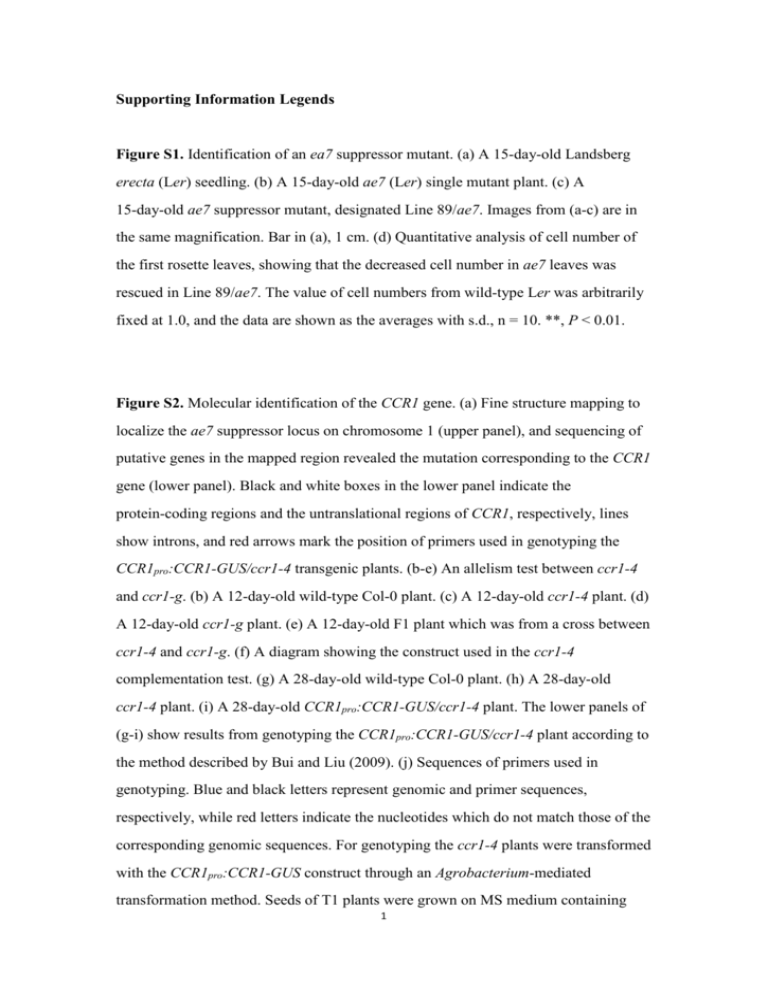
Supporting Information Legends Figure S1. Identification of an ea7 suppressor mutant. (a) A 15-day-old Landsberg erecta (Ler) seedling. (b) A 15-day-old ae7 (Ler) single mutant plant. (c) A 15-day-old ae7 suppressor mutant, designated Line 89/ae7. Images from (a-c) are in the same magnification. Bar in (a), 1 cm. (d) Quantitative analysis of cell number of the first rosette leaves, showing that the decreased cell number in ae7 leaves was rescued in Line 89/ae7. The value of cell numbers from wild-type Ler was arbitrarily fixed at 1.0, and the data are shown as the averages with s.d., n = 10. **, P < 0.01. Figure S2. Molecular identification of the CCR1 gene. (a) Fine structure mapping to localize the ae7 suppressor locus on chromosome 1 (upper panel), and sequencing of putative genes in the mapped region revealed the mutation corresponding to the CCR1 gene (lower panel). Black and white boxes in the lower panel indicate the protein-coding regions and the untranslational regions of CCR1, respectively, lines show introns, and red arrows mark the position of primers used in genotyping the CCR1pro:CCR1-GUS/ccr1-4 transgenic plants. (b-e) An allelism test between ccr1-4 and ccr1-g. (b) A 12-day-old wild-type Col-0 plant. (c) A 12-day-old ccr1-4 plant. (d) A 12-day-old ccr1-g plant. (e) A 12-day-old F1 plant which was from a cross between ccr1-4 and ccr1-g. (f) A diagram showing the construct used in the ccr1-4 complementation test. (g) A 28-day-old wild-type Col-0 plant. (h) A 28-day-old ccr1-4 plant. (i) A 28-day-old CCR1pro:CCR1-GUS/ccr1-4 plant. The lower panels of (g-i) show results from genotyping the CCR1pro:CCR1-GUS/ccr1-4 plant according to the method described by Bui and Liu (2009). (j) Sequences of primers used in genotyping. Blue and black letters represent genomic and primer sequences, respectively, while red letters indicate the nucleotides which do not match those of the corresponding genomic sequences. For genotyping the ccr1-4 plants were transformed with the CCR1pro:CCR1-GUS construct through an Agrobacterium-mediated transformation method. Seeds of T1 plants were grown on MS medium containing 1 hygromycin. A total of 17 independent hygromycin-resistant plants were obtained, which all showed normal phenotype. A wild-type, a ccr1-4, and a T2 transgenic line were genotyped with primers 1 and 3, or 2 and 3. (k) Cell numbers in the first leaves on day 25 of a T2 CCR1pro:CCR1-GUS/ccr1-4 plants were close to those of the same-age wild-type plants. The value of cell numbers from wild-type Col-0 was arbitrarily fixed at 1.0. Bars show the average with s.d., n = 10. **, p < 0.01. Bars in (b-e, g-i), 1 cm. Figure S3. Cell size and cell number per leaf of the ccr1-g mutant. (a, b) Palisade cells of the first rosette leaves on day 12 from wild-type (a) and ccr1-g (b) seedlings. Leaves were analyzed by a DICM and images were taken at the position as shown in Figure 4i. Bars in (a, b), 50 m. (c) Analysis of palisade cell numbers of the ccr1-g plants. The first ccr1-g leaves on day 25 were used in analyses. The value of cell numbers from wild-type Col-0 was arbitrarily fixed at 1.0, and the data are shown as the average with s.d., n = 10. **, P < 0.01. Figure S4. Expression patterns of CCR1 in the root. (a-d) GUS staining to determine CCR1 expression patterns in the root of CCR1pro:CCR1-GUS/Col-0 transgenic plants. Seedlings on day 7 were used in the experiment, and roots stained with 10 min (a), 30 min (b), 1 h (c), 2 h (d), and 16 h (e) are shown. CCR1 is expressed everywhere except the root cap. The vascular cylinder showed the strongest GUS staining, whereas staining in epidermis and cortex appeared relatively weak. Bar in (a-d), 100m. (f) Quantitative analysis of FeA content in the root of seedlings on day 7. FeA was not detected in wild-type Col-0 roots, whereas ccr1-4 roots accumulated high levels of FeA. For comparison, the FeA level in Col-0 leaves on day 7 was served as a control, which was arbitrarily fixed at 1. Data are means + s.e. of three biological replicates. Figure S5. Effects of FeA and H2O2 on cell numbers of cortex in the root meristematic zone. (a-c) Root meristematic zones of seedlings on day 7. (a) Col-0. (b) 2 Col-0 treated with 50 M FeA. (c) ccr1-4. (d) The number of root cortex cells was altered by treatments with FeA or H2O2. The value of cell numbers from wild-type Col-0 was arbitrarily fixed at 1.0. Shown are the averages with s.d., n = 10. **, p < 0.01. Bars in (a-c), 50 m. References Bui, M. and Liu Z. (2009). Simple allele-discriminating PCR for cost-effective and rapid genotyping and mapping. Plant Methods 5:1, doi:10.1186/ 1746-4811-5-1. 3
